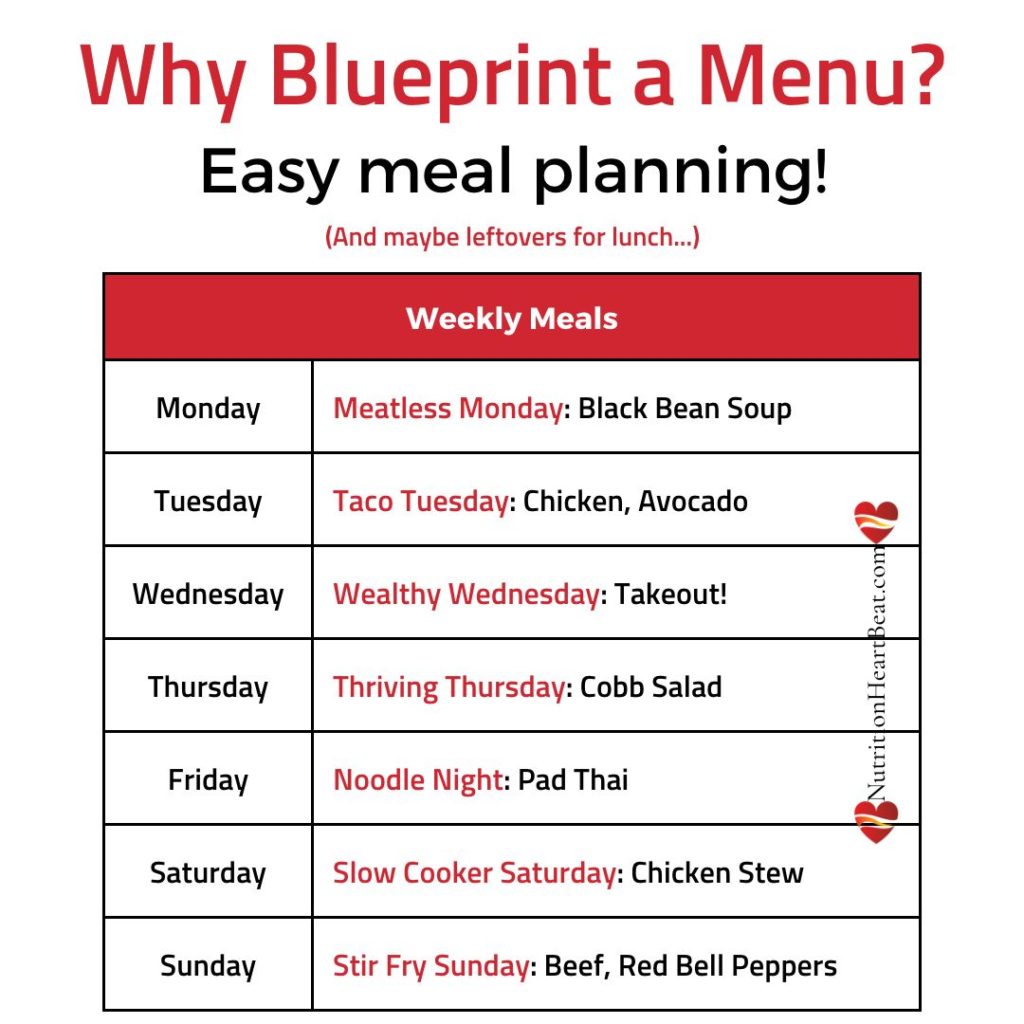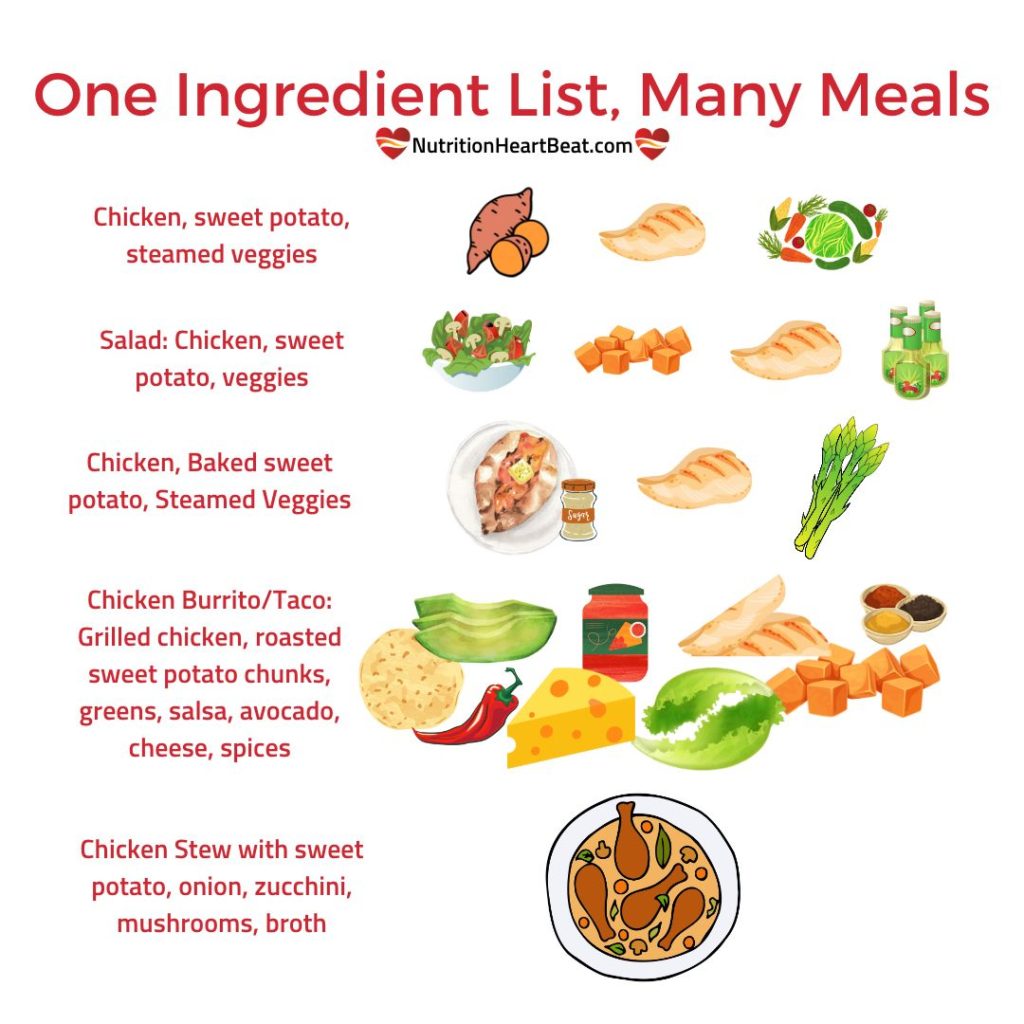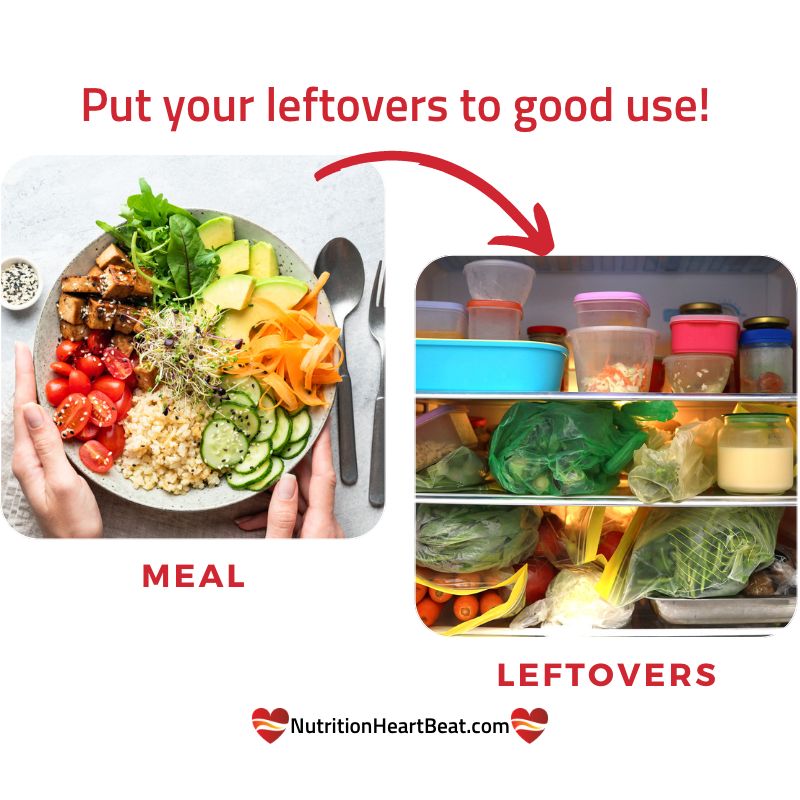Meal planning in advance with blueprints can save time and money so you waste less food!
Meal Planning: What to Consider
Protein. This is often set as 4 oz of raw meat or fish (2-3 oz cooked), sometimes more. 1 egg is one serving. Probably a lot more if you’re cooking for a teenage boy. It’s also a mix of grains and legumes in either 1/2 C or 1 C servings. Think rice and tofu, quinoa and chickpeas, black beans and rice, hummus and whole wheat pita. Or it can be all of the above.
Starchy carbs are next, in either 1/2 C or 1 C servings. This is whole grains, legumes, potatoes, sweet potatoes, winter squash, and pasta.
Fruit and vegetables are essential. Round out that meal with some produce. Salads are great, as is fresh fruit, but the produce can be cooked, steamed, stir fried, roasted, baked, grilled, or dried (usually fruit). Get 2-3 servings (1/2 C – 1 C) per meal. And a TON of flavor. Yum!
Fat is required both for cooking and flavor. This would be the oil used to sauté or stir fry, as well as nuts and seeds, salad dressings, sauces, and cheese topping.
If body composition change is a long term goal, this is one place basic meal planning can help. It can also help ensure you get the nutrients you need for the upcoming training cycles. More fat, less carbs? More protein and carbs? Make sure you get what you need to succeed!
Don’t forget to have a beverage and stay hydrated. This is often water, but could be tea or coffee (caffeinate as you see fit), dairy/non-dairy, juice. Sports drinks might be okay depending on your training schedule. Alcohol should be minimized if you want to succeed in your sport.
Take a Look at your Schedule. What do you need to eat and drink, and when?
Include work, school, training/practice, competitions, travel, pre workout/post workout snacks, and hydration.
Do you need 3 meals a day? Or do you need 3 meals, a post-workout shake and a bedtime snack? Or 2 meals, 3 snacks and a refill on the trail mix you keep in your bag? Include meal and snack times that aren’t at home or school or work in your meal planning.
Blueprinting: Lay Out a General Plan for your Menu
Blueprinting is basic meal planning: laying out a general schedule of what you want to eat when.
Where to do it? Paper, spreadsheet, dry erase board, notes app on your phone, group chat with family members. Whatever works best for you and anyone else with input into the general meal schedule.
Meals don’t have to be alliterative, but it can be kind of fun?

Pick Recipes (Or at least Figure Out how to Wing It!)
Meal planning makes it easy to figure out what you need to buy for the meals in the blueprint.
Making chicken tacos with black beans and salsa on Taco Tuesday?
Make a list (paper, phone, app, delivery website) that includes chicken, canned black beans and salsa, plus hard or soft tacos or tortillas.
If you want to find recipes, great. Have at it! There are millions, if not billions, available for free online for every cuisine and every level of cooking skill. Whatever recipes you decide on, get those ingredients into the shopping list too.
Pro tip: have a general meal template but mix up the spices or sauces. Want to make chicken tacos multiple nights but have different tastes and textures? Add an avocado one night, put it in a bowl without a shell or tortilla but over rice the next, change up the salsa or the spice blend on the chicken the third. Add cheese or change types/flavors of cheese. Change up the beans (black, red, refried). Put it on a bowl of corn instead of rice or tortillas. And add vegetables.
It is 100% OKAY to use short cut ingredients. Hate chopping onions? Buy the pre-chopped frozen ones in the freezer aisle. Unsure how to cook meat? Buy the pre-cooked chicken strips or sausage. Same with canned beans. Or the grains you can cook in the microwave.

Shop
This can be as easy as ordering online and waiting for delivery or as difficult as going to the store at a busy time.
Pro tip: if you’re shopping in person, go during off hours. Consider evenings after 8 PM or early afternoons. DO NOT go right after work – especially on Monday – or Saturday or Sunday mornings. Too late in the evening and the store will be restocking. This makes it difficult to get around the store and the checker might have wandered off. It’s better than going after work but still has some inherent difficulties.
Don’t forget the veggies! I’m sure you included those in your meal planning…
If you’re on a budget, you can shop at discount stores, look for sale items, join store reward/loyalty/discount programs, or shop from a variety of stores to get sales at each store. This is great, but it does add time and layers of complexity.
Maybe Prep?
Depends on how tight the schedule is. If the schedule is tight later in the week, this can be useful if you have real recipes. If you have to grill, bake, roast, this can save a LOT of time later in the week.
Pro tip: if you don’t really know how to use a knife in the kitchen, look for knife skills videos, take a class, or ask for help from someone who has knife skills. Also, get a real chef’s knife, a paring knife and a bread knife and learn how to keep them sharp.
Cooking
As above with the pre-cut foods, it’s okay to use some convenience foods in your cooking and meal planning. Canned beans and cut veggies, frozen potatoes and veggies (see onion, above), frozen fruit, microwaveable grains (pretty much all of them), microwaveable starches (pasta, pierogies and most frozen dumplings of any kind), anything you can roast or grill whole or cut in half, nuts and nut butters, seeds, dried fruit, herbs/spices/blends, sauces (BBQ, fruit, stir fry), dressings (Caesar, vinaigrettes), syrups, etc.
Yes, you really do need to include veggies.
Packaging Food for Travel or Future Meals
What if you have leftovers? These are a great idea, provided you can stand to eat them. Some people can’t, in which case redo your meal planning and cooking strategy to not waste food and money!
Figure out a way to package them for future meals. This is also part of meal planning! That might mean you have to invest in containers. Do they need to be freezer proof? Seal to keep in sauces or dressings? Be of a particular size to fit in a work bag or briefcase?
Pro tip: Are you using a starch (rice, quinoa, beans, lentils, pasta, potatoes, sweet potatoes, etc.) that absorbs sauce over time? You might pack a bit of additional sauce to rejuvenate the meal before eating.

Make a (mental) Note About What Works for Meal Planning
As you try this out, some meal planning ideas will work and some won’t. This is fine. Keep track of what worked so you can do it again. Discard any ideas that didn’t. Veggies work, so keep those in the mix! 😉
What about Eating Out and Takeout/Delivery Foods?
These are fine occasionally, but those meals and foods are designed to sell well. They’re tasty, they’re pretty and they make you want more. They’re not designed to provide the nutrients you need to succeed in your sport. Things happen, so don’t feel like you can never do this. But it’s not a solid strategy for winning.
Need more Insight into Meal Planning?
Contact Dr. Schubert here for specifics on meal planning or what to eat when around a heavy training schedule!
Here’s a complete list of ways to consume nut butters (if you’re allergic to nuts, please don’t eat nuts!) and another on smoothies. Overnight oats have a huge variety of options as well.
